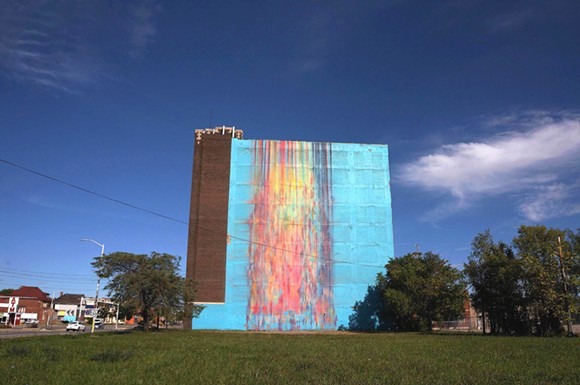
(DETROIT, MI) – When Detroit-based artist Katie Craig sued developer Princeton Enterprises under the Visual Artists Rights Act last January, her federal lawsuit was heralded as a major legal showdown over artists’ rights. Now the two sides are settling.
The artist and the developer jointly announced today that they have resolved their dispute over the fate of The Illuminated Mural—a nine-story mural on the side of 2937 East Grand Boulevard. The settlement agreement will ensure the preservation of the 100-by-150 foot painting, which has become one of the city’s most notable works of public art since its creation in 2009. It has been called “maybe Detroit’s most drop-dead gorgeous mural,” and “a rich and irreplaceable work of art.”
“The Illuminated Mural is a significant achievement in my career, and it has received recognition nationally and internationally,” Katie said. “The Visual Artists Rights Act provided me a way to ensure that the Mural is protected, and the confidential settlement that we reached honors and extends the original agreement that governed its creation.”
With cascading streams of orange, yellow, green, and magenta paints down a vibrant, blue background, The Illuminated Mural sits on the façade of an Albert Kahn-designed building in the city’s North End. Katie received a competitive grant administrated by the College for Creative Studies to honor a public artist worthy of creating long-lasting and highly visible work of public art in the community, and secured support from neighborhood groups and permission from the building’s then-owner before embarking on the project.
“There’s a tension between the forces of economic change and the preservation of public art in Detroit and other cities across the country,” said a lawyer for Katie, Amy E. Keller of Wexler Wallace LLP in Chicago, Illinois. “This settlement should be seen as a model for positive collaboration, and should help ensure that Detroit’s vibrant artistic and cultural legacy remains intact as the city develops.”
Katie’s lawsuit sought protection under the Visual Artists’ Rights Act. Passed by Congress in 1990, this law extends special legal provisions to visual artists, and, for works of recognized stature like The Illuminated Mural, prohibits any kind of distortion, mutilation, or destruction. The law specifically extends protection to significant public murals that could not be removed from a building without being destroyed. Katie’s lawsuit sought an injunction barring the building’s developer from destroying or otherwise altering the mural.
“Today’s settlement is a victory for the preservation of artists’ rights,” said Deepak Gupta of Gupta Wessler PLLC, in Washington, DC, one of Katie’s lawyers. “It shows that development and art can coexist. In the future, developers won’t be able to ignore the law.”
The building at 2937 East Grand Boulevard is currently under contract to be sold to The Platform LLC, which intends to incorporate the Illuminated Mural in its development plans for the building. The settlement guarantees that The Platform will honor and extend a previous agreement to ensure the Mural’s protection.
0 Comments